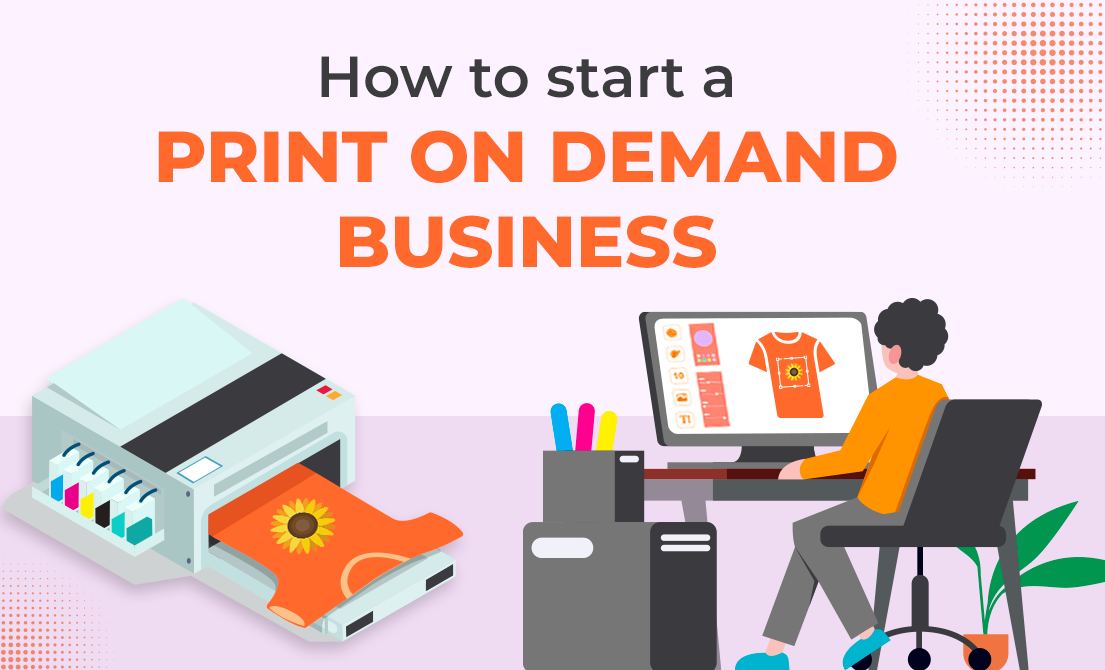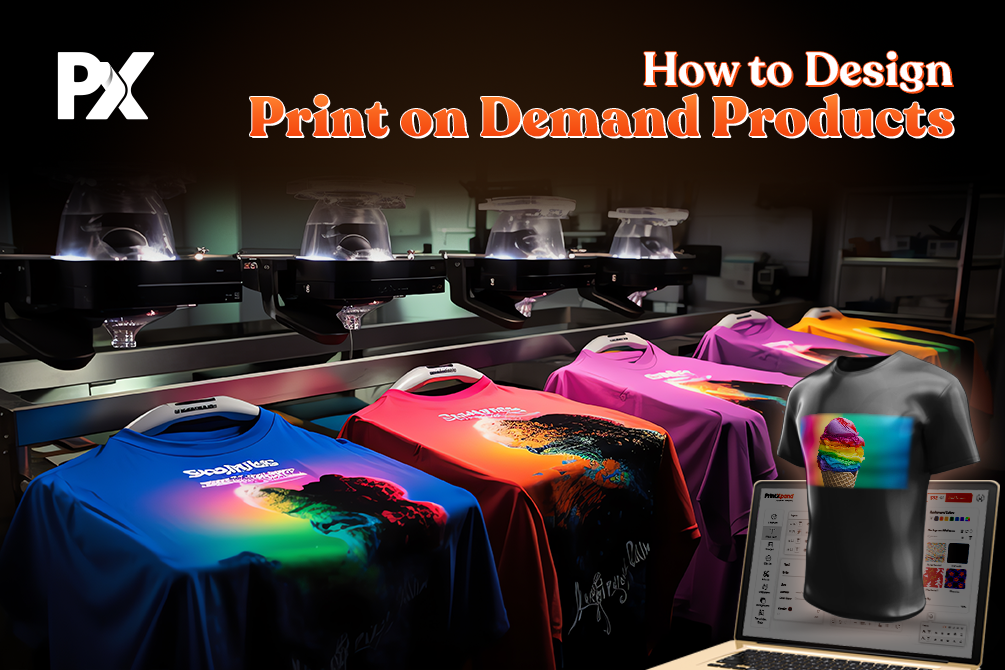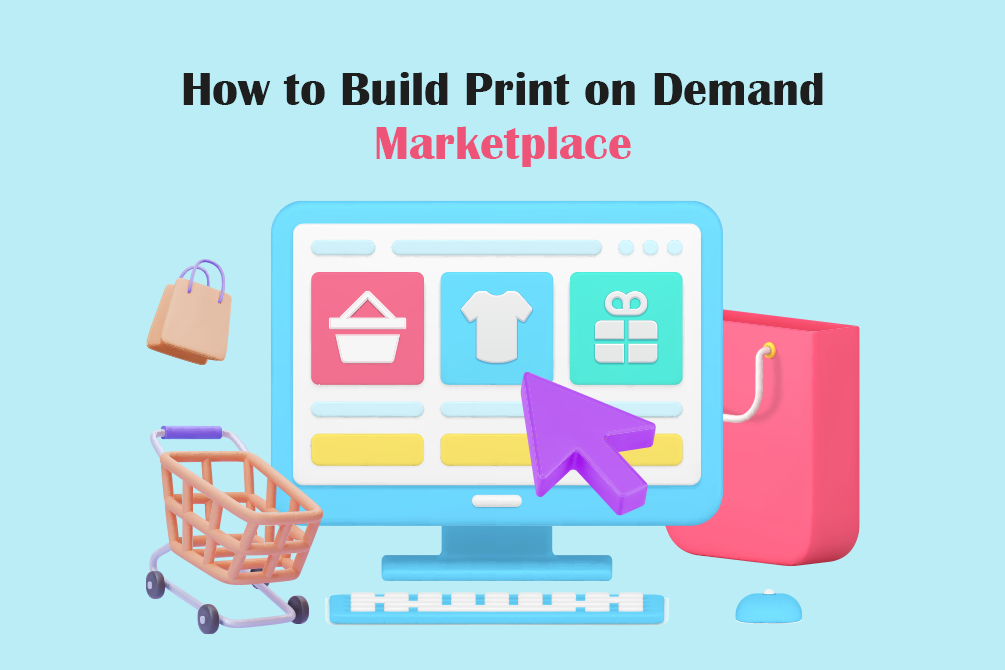
Of course, you know this already!
Marketplaces are steadily growing. Traditional marketplace models, whether it’s Amazon, eBay, Facebook Marketplace, or even your own, drives in more visibility and sales.
However, traditional marketplaces lack the ability to sell customizable products.
Here’s a major issue that even veterans face.
You bet your cash on high volumes of products to fulfill the demand. And by any chance, if the designs of your products do not sell, you are left with a humongous stock and no money.
Now, we want you to look at a bigger picture beyond a traditional marketplace. How about you enable customization to let your customers to create and buy personalized products on demand!
You can invite other businesses to collaborate with you, and in a way, earn commissions. Additionally, with print on demand, you can have unlimited product options without having to worry about operating costs.
If that sounds interesting, this blog is for you! It covers all the aspects of print on demand technology, marketplace, and how to build print on demand marketplace.
Here’s an outline of the topics this post covers:
- Why Print on Demand + Marketplace is a Combo That Can Never Go Wrong
- How Print on Demand Marketplace Works
- Choosing What Products to Sell
- Integrate Product Design Tool with Your Platform
- Must Have Features in Your Print on Demand Marketplace
- Decide Your Monetization Model
- Promote Your Print on Demand Marketplace
Why Print on Demand + Marketplace is a Combo That Can Never Go Wrong
Print on Demand and marketplace are two concepts that are being widely adopted in the eCommerce space. Let’s get into some serious number business to understand in depth.
Marketplace in Numbers
More and more customers have started buying from online marketplaces. On average, U.S. power shoppers conduct 50% of their online shopping through marketplaces.
Savvy industry players, in order to cater to this shift in buying habits, are building their own digital marketplaces.
Did you know in the last 7 years, more than half online marketplaces have been launched? This clearly implies that there has never been a better time to build your own marketplace to remain competitive.
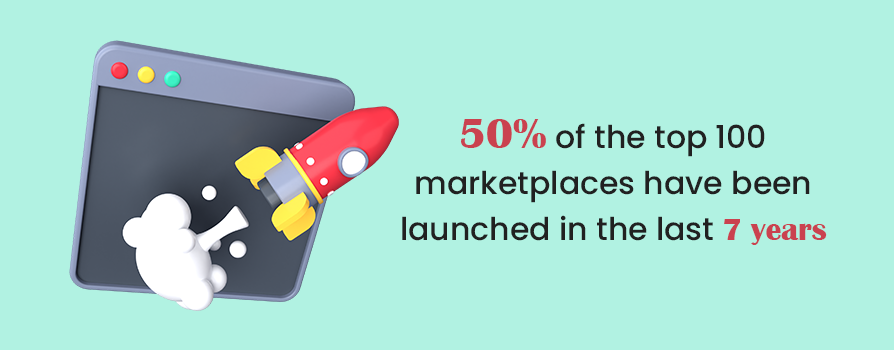
(The rise of online marketplaces)
Print on Demand in Numbers
Unlike traditional business structure, Print on Demand enables you to create uniquely designed print products without having to physically hold any inventory.
It opens doors to generating high profits by eliminating operating expenses. And that’s why there is no wonder why this model is becoming so popular.
With over 12% growth in the last four years, the industry is showing no signs of slowing.
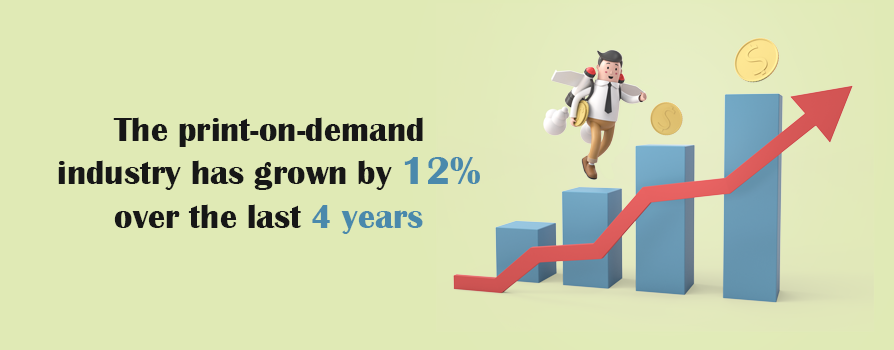
(The growing popularity of print on demand model)
Future Market Insights also projects that the print-on-demand software market will grow at a CAGR of 31.1% during the period of 2022–2032 and reach a valuation of US$30 billion by 2032.
The industry’s growth is driven by factors such as the increasing demand for customized products, the growth of e-commerce, and the advancement of technology that makes it easier to create and sell personalized products.
By combining both these profitable business models, you can have your own marketplace platform and achieve what you have set to achieve – repeat business and high profit!
Get an in-depth understanding of how you can get started with print marketplace development. Share with us your business requirements, and we will get back to you!
How Print on Demand Marketplace Works
It’s time to get a practical approach to things.
The most basic way to understand this Print on Demand marketplace is to consider it as a centralized platform. Here, you invite other businesses, or artists/designers.
Whether you choose to have a B2B marketplace or a C2C marketplace, depends on your business requirements.
In both of these, each business entity – a vendor or an artist, will have their independent branded stores. From here, they can manage their orders, customers, products, designs, payments, etc.
The vendors coming to your store will either have their existing catalog or will use your inventory. If they purchase your inventory, you get a commission on each item sold.
As far as shipping and printing infrastructure is concerned, your vendors can have their own infrastructure or you can do it for them. You can also invite your suppliers, and printers to smoothly manage all operations.
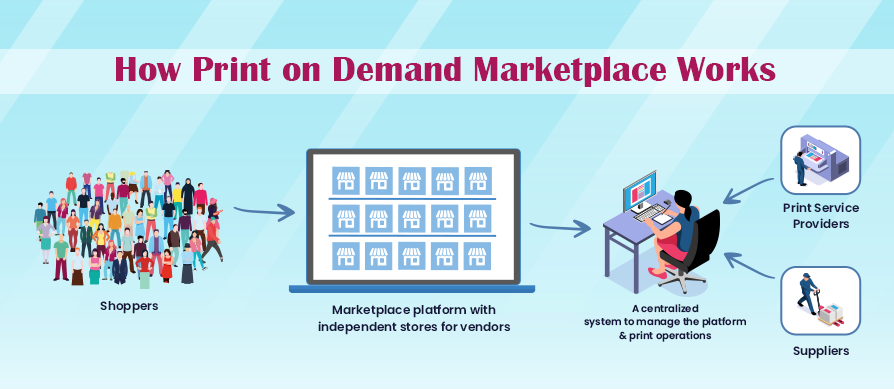
If you look at the image, your print marketplace works as a centralized system, where hundreds of other business entities be it vendors, or resellers who have their individual stores.
Vendors can either upload their existing products on the print marketplace, or leverage your catalog. They also have access to a Product Design Tool to create and sell customizable products to end-customers.
Know more about print on demand marketplace development by clicking the link below.
The following sections of the post covers all the information you need to know about print marketplace development. Features, product customization, monetization model – continue reading!
Choosing What Products to Sell
There are plenty of options when it comes to choosing customized products. The biggest decision you will make is to have either a vertical marketplace or a horizontal marketplace.
Amazon, Alixpress, these are horizontal marketplaces where you get products of almost all categories. It is like a one stop shop where you sell multiple product categories like gifts under one roof.
On the other hand, vertical marketplaces are the ones that deal with specific categories. For instance, Etsy, it deals with a very narrow segment – handmade and vintage goods.
Irrespective of the category you choose, if you are wondering what are some trending customizable products that you can sell, then here’s something that will help you.
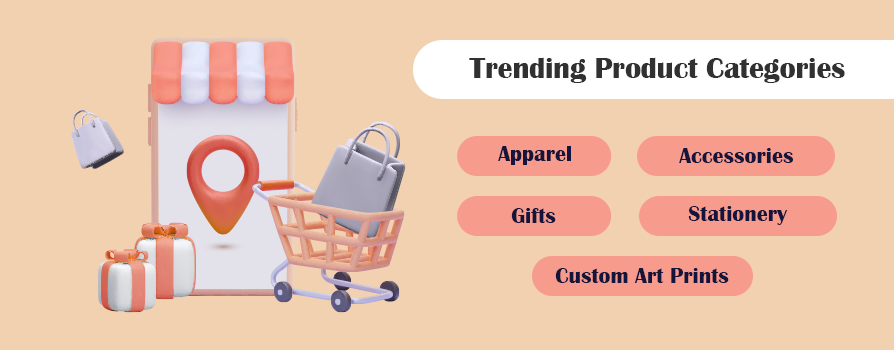
No Debate Here – These Categories Take the Foremost Position
After going through tons of articles from Shopify, Oberlo, Printify, etc. here are some categories we think are the most popular.
It includes apparel, accessories, gifts, stationery, and custom art prints. The demand for products like tees, hoodies, pants, etc. will always remain high, undoubtedly.
Products like custom wall prints, art posters, engraved jewelry, etc. are also among the fastest growing segments. An in-depth market analysis will help you pick the right options for your business.
Even if you have an existing catalog, keeping an eye on the latest trends will help you stay ahead of the curve.
In 2023, there are even more options when it comes to choosing what products to sell on a print-on-demand marketplace.
Beyond t-shirts, mugs, and phone cases, entrepreneurs can explore other product categories such as home decor, stationery, and even furniture.
Any Exciting Trend That You Need to Know?
Three of the most popular trends are eco-friendly products, unisex clothing options, and all over prints.
More and more customers are looking for buying sustainable products including clothing, bags, bottles, recycled packaging, greeting cards, and such.
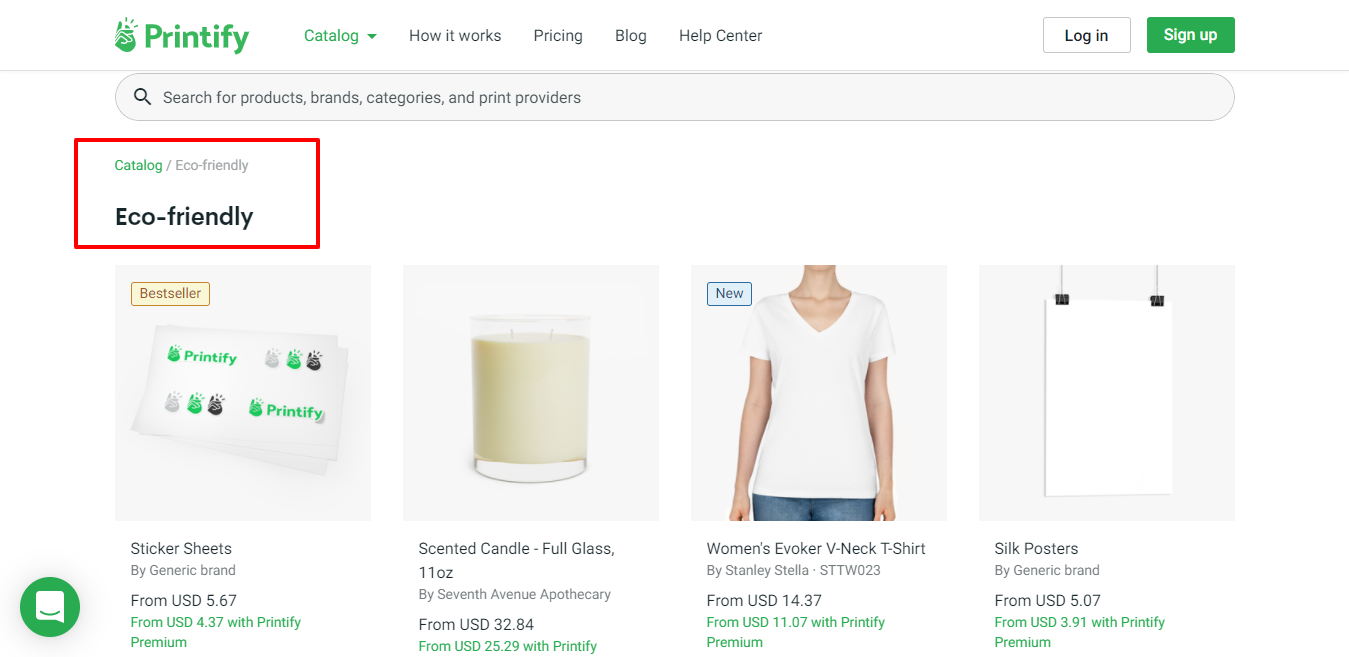
Idea in Action: Printify has an entire section dedicated to eco-friendly products. They sell custom printed sustainable travel mugs, apparel, bottles, etc. They even use sustainable printing methods like Direct to garment to promote environmentally friendly eCommerce.
Another trend that has hit the world of personalized apparel is all-over printing. It is a kind of print that covers the entire apparel, both front and back side. Such kind of print design can have either tiny patterns, images covered everywhere, or just a single design.

Idea in Action: Yizzam is a US-based sublimation printing company that specializes in t-shirts and tank tops. Their print designs range from vintage to retro to modern art patterns.
Take your printing business a step ahead by integrating a fully-functional and feature-rich product design tool.
Lastly, unisex pullovers have become one of the top-selling items in the print on demand industry. Customers love the versatility and comfort of pullovers that can be worn by both men and women. Many print on demand platforms offer a wide range of unisex pullovers in various colors and styles.
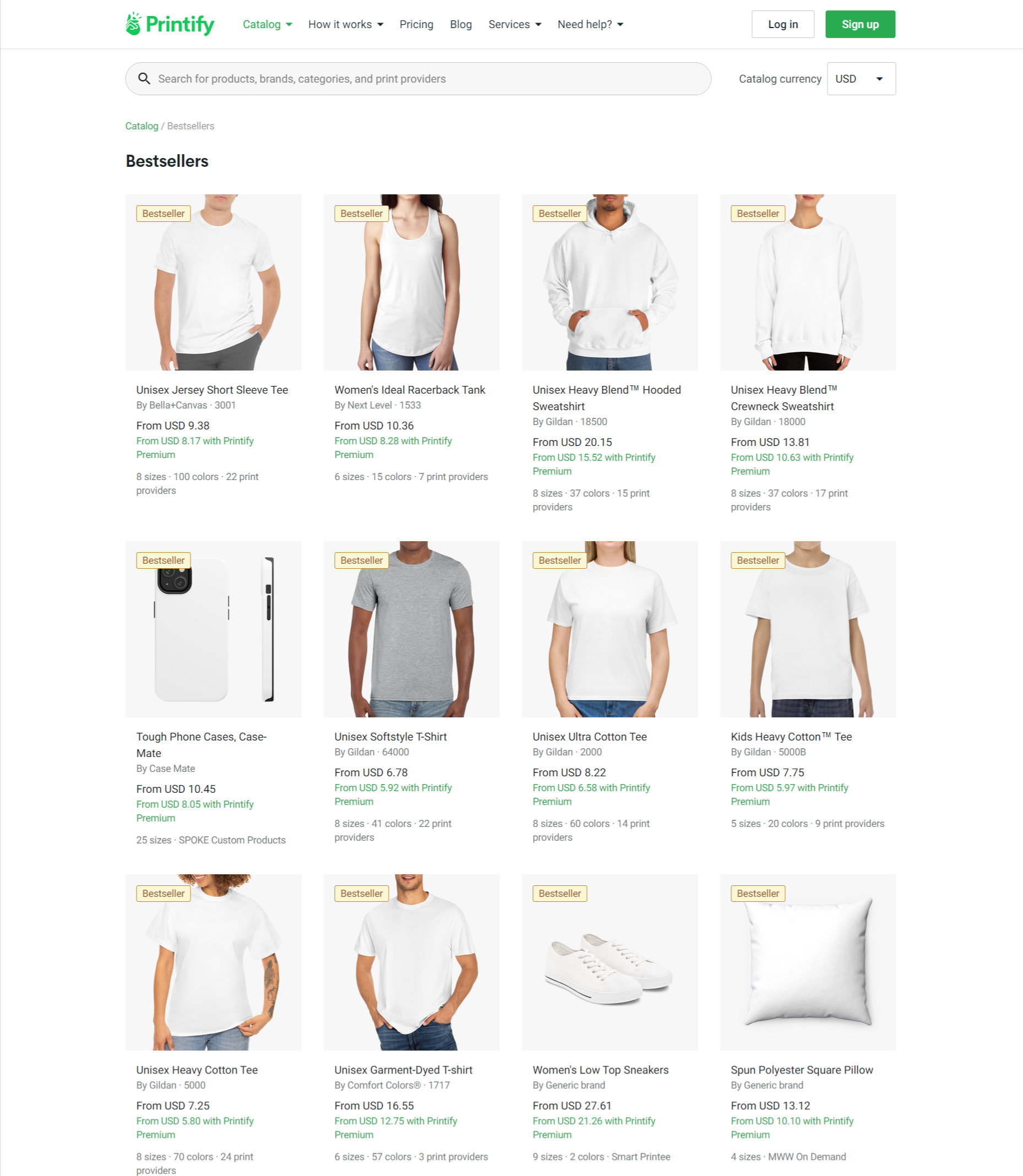
Idea in Action: Printify and Printful both have a variety of best-selling unisex pullovers that can be customized with unique designs.
Some popular styles include the Gildan Heavy Blend Hooded Sweatshirt, the Bella + Canvas Unisex Sponge Fleece Pullover Hoodie, and the Independent Trading Co. Lightweight Hooded Sweatshirt.
Print-on-demand businesses can offer these popular items to their customers and customize them with unique designs to stand out from the competition.
Let your customers add their ideas and create products they love! Click the link below to learn more about all the features that make customization successful.
Integrate Product Design Tool with Your Platform
Marketplace owners often get caught in the vicious cycle of not being able to attract more customers because there are no sellers, and vice versa.
There are various marketing techniques that will help you get sellers and buyers on your marketplace.
However, when it comes to retaining customers, and building a loyal customer base, you need to have a solid USP. With Design Tool, you can offer uniqueness of personalized products to users.
Whether it’s adding a fandom meme, favorite quote, or personal picture, there are endless ways end-customers can add a personal touch.
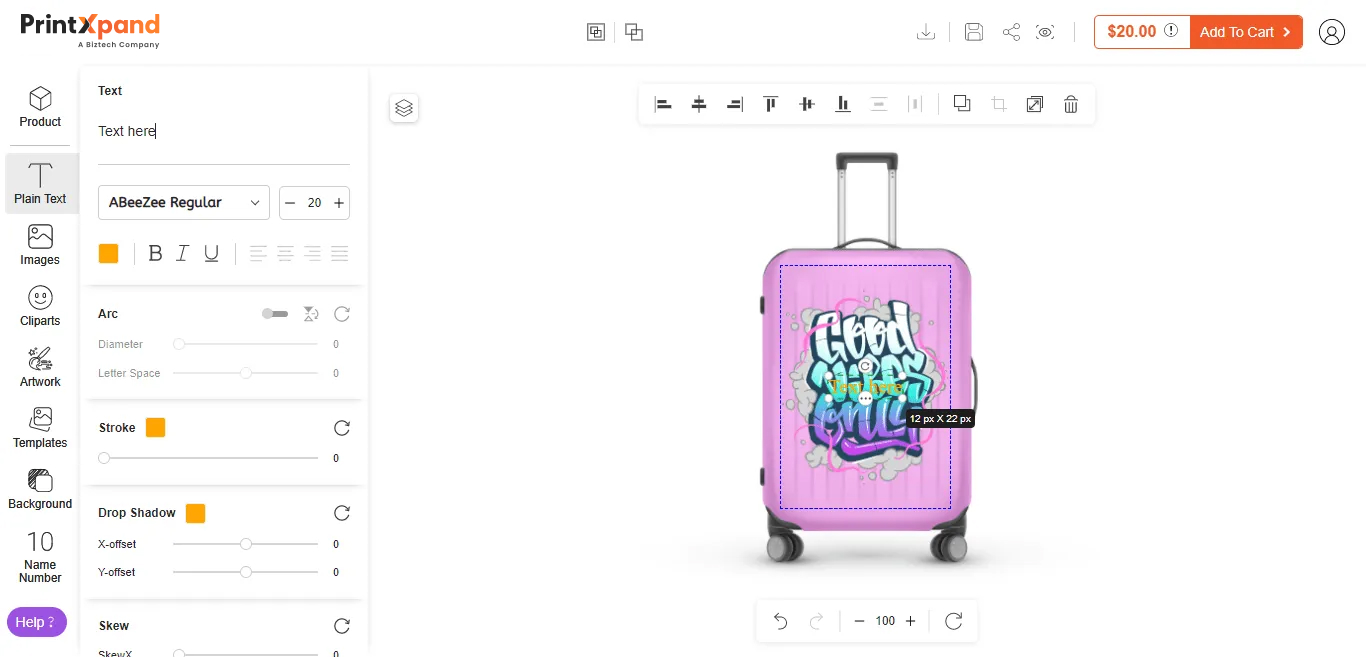
By integrating a Product Design Tool on your platform, you can offer such uniqueness. Here, each vendor on your platform has access to the tool.
They can enable a ‘Design Your Own’ option on their stores to sell customizable products. There are two ways to enable customization.
One is to offer design-ready templates. Not every end-customer who comes on your marketplace might have the time or need to design a product from scratch.
Instead, they can choose from a pre-loaded template library, make modifications in color, text, background, etc. as required.
On the other hand, those shoppers who really wish to design their products from scratch, can benefit from several other features like clipart, artwork, quotes, and so on.
Want to know how the tool works as per your industry? Share your business details with us, and we will give you a personalized tour of our product.
Must Have Features in Your Print on Demand Marketplace
What features do you need to build a print on demand marketplace? This section talks about everything you need to know.
Quick Onboarding for Other Stakeholders
Your marketplace needs to have a user-friendly and quick on-boarding process. With a straight-forward sign-up, you can enable vendors, artists, printers, etc. to register and create their account on your marketplace. This is also probably the first interaction sellers will have with your marketplace. Hence, it is important to deliver a smooth onboarding experience.
Approve /Reject Requests & Role Based Access
You also get the ability to approve or reject any request. Further, by leveraging notifications, you can send real-time updates to the vendors regarding their registration status. Once you approve it, vendors can have their individual backend portal. Further, admin can also define user roles and assign privileges to members of an access group.
Independent Branded Stores
Each business joining your print on demand marketplace will require a dedicated store to showcase their offerings. With PrintXpand’ ready Web to Print Store, you can easily enable them to build fully customized and responsive stores. Using various in-built themes, theme editor, and page layouts, they can design unique stores. Their web stores can also feature customer reviews, recommended products, and such to help end-customers make better purchase decisions.
Pull Inventory & Mass Product Upload
For those sellers who do not have their own inventory, the pull inventory feature comes in handy. As the name suggests, they can pull your existing inventory to their stores and sell it to their customers. In such a scenario, you can charge them a fee to avail this benefit. Secondly, for sellers who have their products, they can easily upload all their products in a go using the mass upload feature.
Advanced Dashboard & Reporting
Both you and vendors need to be able to see everything that’s happening in order to manage operations, and take further decisions. A dashboard can be dynamic based on your business requirements. However, at minimum, a dashboard needs to offer information like number of vendors, pending requests, catalog, customers, analytics and reporting, payment information, and such.
Payment & Commission Module
Payment module is an important feature that helps admin and vendors alike. It lets one manage all transactions whether it’s between a vendor and admin or vendor and end-customers seamlessly. Further, the commission module gives admins the ability to set commission for products, printing, shipping, etc.
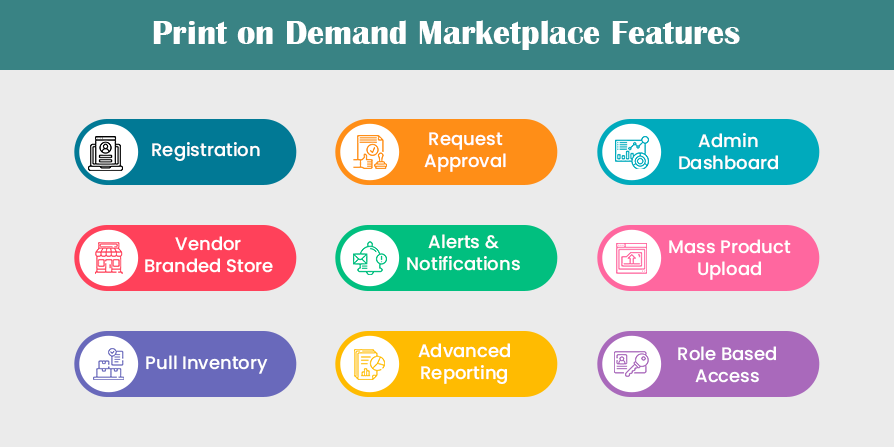
Get started with print marketplace development with us. Start selling personalized products using the Design Tool integrated with your marketplace.
Decide Your Monetization Model
An important factor that leads to high income is choosing the right monetization model. In this section, we will talk about two of the most common monetization models you can leverage for your print on demand marketplace.
Commission Based Model
In this revenue model, you charge a user a fee for each transaction. And that’s actually the biggest advantage of this model is that with each transaction, you can monetize.
As the marketplace owner, you can charge a fixed fee to either the vendor or the end-customer or both. The commission percentage entirely depends on your industry.
The biggest challenge with the commission model is to offer more value to the users. You will need to offer both vendors and buyers some uniqueness in order for them to do business with you. In such a case, having the ability of product customization can be beneficial!
Listing Based Model
Listing is quite similar to the commission-based model. The only difference is that in the latter vendors pay you a fee only when they sell an item while in listing, you can charge vendors to list their products on the platform.
While listing fee is a great option if you have a wide customer base, the biggest challenge is the price. There are chances sellers might go away owing to high listing fees.
With listings, it’s hard to get enough revenue. It is always advisable to have commission as your primary model and listing fee as your secondary revenue model.
In addition to these models, you can also generate revenue through advertising, sponsorships, and partnerships with other businesses.
Here are a few examples:
- Advertising: You can offer advertising space on your website, social media accounts, or email newsletters to other businesses that are relevant to your target audience. For example, if you sell personalized mugs, you could partner with a coffee company to advertise their products on your website or social media.
- Sponsorships: You can also seek out sponsorships from companies that are interested in reaching your target audience. For example, if you have a YouTube channel or podcast focused on print on demand, you could seek out sponsorships from companies that sell printing equipment or supplies.
- Partnerships: You can partner with other businesses to offer complementary products or services. For example, if you sell custom t-shirts, you could partner with a local sports team to create custom t-shirts for their fans. This not only generates revenue, but it also helps you reach new customers who may not have been aware of your business before.
Promote Your Print on Demand Marketplace
Gaining traction in the online market has become more challenging than ever before. And the nature of the marketplace model makes it even more difficult. You have to take care of both vendors and buyers.
Have a look at a few strategies that will help you market your platform and bring in more vendors and customers.
- Join online communities like a Facebook or a LinkedIn group. Connect with relevant people, take part in discussions, etc. Gradually, you can pitch in your platform, and get potential vendors for your marketplace.
- Hangout on platforms where potential buyers are. You can create some interesting pre-launch content like a sneak-peek video and share it on social media.
- You can also take advantage of email marketing. You can inform users about your marketplace, list its benefits, talk about the features, etc.
Ready to Get Started?
Print marketplace that enables end-customers to create custom designs on demand; it is one of the fastest growing models in the eCommerce industry. We can help you successfully build a print on demand marketplace as per your needs.
For more than 15 years, we have been enabling businesses in the print and eCommerce industries to leverage web to print technology to build, manage, and grow their business. We have a skilled and experienced team of developers, designers, and industry specialists who can help you build custom and secure marketplaces.
In order to get a detailed overview of print on demand marketplace development, and what features you need as per your business logic, let’s get in touch! Share your requirements with us, and we will get back to you!
All product and company names are trademarks™, registered® or copyright© trademarks of their respective holders. Use of them does not imply any affiliation with or endorsement by them.


